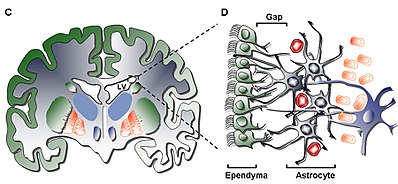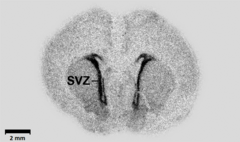This article may be too technical for most readers to understand. (August 2022) |
| Subventricular zone | |
|---|---|
| Identifiers | |
| NeuroLex ID | nlx_144262 |
| Anatomical terms of neuroanatomy | |


The subventricular zone (SVZ) is a region situated on the outside wall of each lateral ventricle of the vertebrate brain.[2] It is present in both the embryonic and adult brain. In embryonic life, the SVZ refers to a secondary proliferative zone containing neural progenitor cells, which divide to produce neurons in the process of neurogenesis.[3] The primary neural stem cells of the brain and spinal cord, termed radial glial cells, instead reside in the ventricular zone (VZ) (so-called because the VZ lines the inside of the developing ventricles).[4]
In the developing cerebral cortex, which resides in the dorsal telencephalon, the SVZ and VZ are transient tissues that do not exist in the adult.[4] However, the SVZ of the ventral telencephalon persists throughout life. The adult SVZ is composed of four distinct layers[5] of variable thickness and cell density as well as cellular composition. Along with the dentate gyrus of the hippocampus, the SVZ is one of two places where neurogenesis has been found to occur in the adult mammalian brain.[6] Adult SVZ neurogenesis takes the form of neuroblast precursors of interneurons that migrate to the olfactory bulb through the rostral migratory stream. The SVZ also appears to be involved in the generation of astrocytes following a brain injury.[7]
- ^ Popp A, Urbach A, Witte OW, Frahm C (2009). Reh TA (ed.). "Adult and Embryonic GAD Transcripts Are Spatiotemporally Regulated during Postnatal Development in the Rat Brain". PLoS ONE. 4 (2): e4371. Bibcode:2009PLoSO...4.4371P. doi:10.1371/journal.pone.0004371. PMC 2629816. PMID 19190758.
- ^ Quiñones-Hinojosa, A; Sanai, N; Soriano-Navarro, M; Gonzalez-Perez, O; Mirzadeh, Z; Gil-Perotin, S; Romero-Rodriguez, R; Berger, MS; Garcia-Verdugo, JM; Alvarez-Buylla, A (Jan 20, 2006). "Cellular composition and cytoarchitecture of the adult human subventricular zone: a niche of neural stem cells". The Journal of Comparative Neurology. 494 (3): 415–34. doi:10.1002/cne.20798. PMID 16320258. S2CID 11713373.
- ^ Noctor, SC; Martínez-Cerdeño, V; Ivic, L; Kriegstein, AR (February 2004). "Cortical neurons arise in symmetric and asymmetric division zones and migrate through specific phases". Nature Neuroscience. 7 (2): 136–44. doi:10.1038/nn1172. PMID 14703572. S2CID 15946842.
- ^ a b Rakic, P (October 2009). "Evolution of the neocortex: a perspective from developmental biology". Nature Reviews. Neuroscience. 10 (10): 724–35. doi:10.1038/nrn2719. PMC 2913577. PMID 19763105.
- ^ Quiñones-Hinojosa, A; Chaichana, K (Jun 2007). "The human subventricular zone: a source of new cells and a potential source of brain tumors". Experimental Neurology. 205 (2): 313–24. doi:10.1016/j.expneurol.2007.03.016. PMID 17459377. S2CID 20491538.
- ^ Ming, GL; Song, H (May 26, 2011). "Adult neurogenesis in the mammalian brain: significant answers and significant questions". Neuron. 70 (4): 687–702. doi:10.1016/j.neuron.2011.05.001. PMC 3106107. PMID 21609825.
- ^ Lim, Daniel A.; Alvarez-Buylla, Arturo (May 2016). "The Adult Ventricular–Subventricular Zone (V-SVZ) and Olfactory Bulb (OB) Neurogenesis". Cold Spring Harbor Perspectives in Biology. 8 (5): a018820. doi:10.1101/cshperspect.a018820. ISSN 1943-0264. PMC 4852803. PMID 27048191.